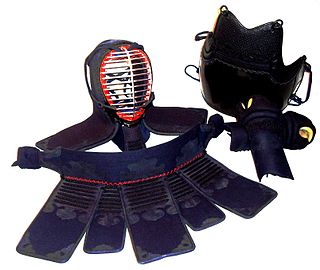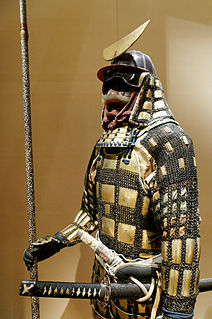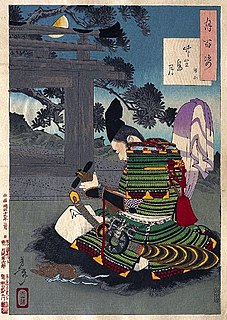 W
WAuxiliary armour in a set of Japanese armour are optional pieces worn by the samurai class of feudal Japan in addition to the traditional six armour components.
 W
WBōgu , properly called kendōgu , is training armour used primarily in the Japanese martial art of kendo, with variants used for jūkendō, tankendo, and naginata.
 W
WDō or dou is one of the major components of Japanese armour worn by the samurai class and foot soldiers (ashigaru) of feudal Japan.
 W
WDō-maru (胴丸), or "body wrap", was a type of chest armour worn by the samurai class of feudal Japan. Dō-maru first started to appear in the 11th century as an armour for lesser samurai and retainers. Like the ō-yoroi style it became more common in the Genpei War at the end of the 12th century.
 W
WHaramaki is a type of chest armour worn by the samurai class of feudal Japan and their retainers.
 W
WKabuto is a type of helmet first used by ancient Japanese warriors, and in later periods, they became an important part of the traditional Japanese armour worn by the samurai class and their retainers in feudal Japan.
 W
WKaruta was a type of armour worn by samurai warriors and their retainers during the feudal era of Japan. The word karuta comes from the Portuguese word meaning "card", (carta) as the small square or rectangular plates that compose the armour resemble traditional Japanese playing cards.
 W
WKikko are small iron or hardened leather, hexagon shaped armour plates used in the construction of Japanese armor worn by samurai and ashigaru of feudal Japan.
 W
WKusari gusoku (鎖具足) is the Japanese term for mail armour. Kusari is a type of armour used by the samurai class and their retainers in feudal Japan. When the word kusari is used in conjunction with an armoured item it usually means that the kusari makes up the majority of the armour defence.
 W
WA lame is a solid piece of sheet metal used as a component of a larger section of plate armor used in Europe during the medieval period. It is used in armors to provide articulations or the joining of the armor elements. The size is usually small with a narrow and rectangular shape. Multiple lames are riveted together or connected by leather straps or cloth lacing to form an articulated piece of armor that provides flexible protection. The armor worn by the samurai class of feudal Japan used lames in the construction of many of their individual armor parts. The Japanese term is ita, which can both refer to the lame or its borderings.
 W
WMen-yoroi (面鎧), also called menpō (面頬) or mengu (面具), are various types of facial armour that were worn by the samurai class and their retainers in feudal Japan. These include the sōmen, menpō, hanbō or hanpō, and happuri.
 W
WThe ō-yoroi (大鎧) is a prominent example of early Japanese armor worn by the samurai class of feudal Japan. The term ō-yoroi means "great armor."
 W
WThe O-yoroi Armor of Ashikaga Takauji [白絲威褄取鎧(しろいとおどしつまどりよろい)]Shiro-ito Odoshi Tsumadori O-yoroi) is a piece of Japanese armour made for the shogun of the Ashikaga shogunate, Ashikaga Takauji. This piece of armor belongs in the Arms and Armor Department of the Metropolitan Museum of Art.
 W
WSangu is the term for the three armour components that protected the extremities of the samurai class of feudal Japan.
 W
WTatami (畳具足), or tatami gusoku and gusoku, was a type of lightweight portable folding Japanese armour worn during the feudal era of Japan by the samurai class and their foot soldiers (ashigaru). The Tatami dō or the tatami katabira were the main components of a full suit of tatami armour.